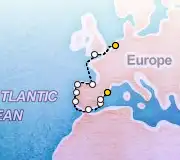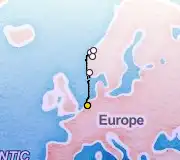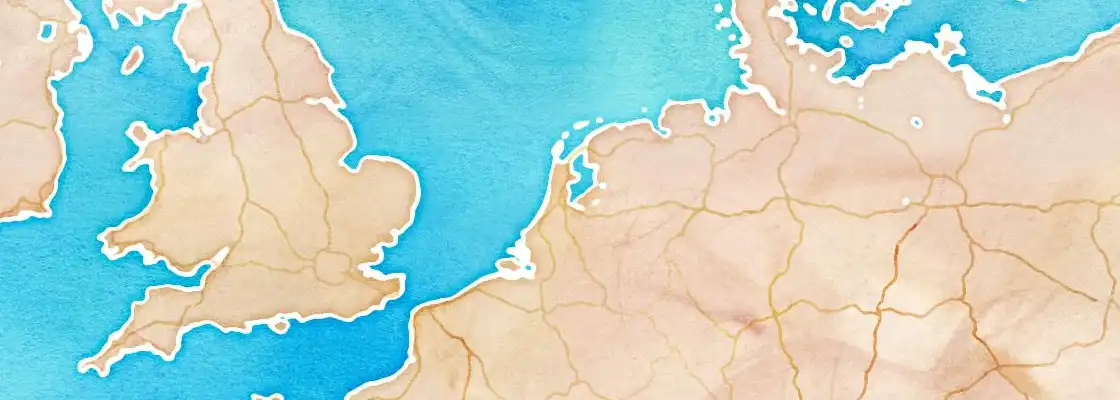The Port of Amsterdam is a major European seaport located in the province of North Holland. It is connected to the North Sea through the long North Sea Canal, making it a deep-water, non-tidal port accessible to large cruise ships. It is a historic port that has been a center of trade and commerce for centuries and remains one of the busiest ports in Europe.
For cruise passengers, Amsterdam serves as both a popular port of call and a major embarkation and debarkation point for Northern Europe and Baltic Sea itineraries, as well as European river cruises. Its modern facilities at the Passenger Terminal Amsterdam (PTA) are designed to handle large volumes of passengers efficiently, providing a seamless start or end to a cruise vacation.
The Rijksmuseum is a national museum dedicated to Dutch arts and history, showcasing masterpieces by Rembrandt, Vermeer, and others. It is easily reachable from the port via a short tram ride from Centraal Station.
A visit to the Anne Frank House offers a poignant look into history. This is an extremely popular attraction, and tickets must be booked online, often months in advance, as they are not sold at the door.
Art lovers should not miss the Van Gogh Museum, which houses the largest collection of artworks by Vincent van Gogh in the world. Like the Rijksmuseum, it is located on the Museumplein (Museum Square).
A canal cruise is perhaps the most iconic way to see the city. Gliding through the historic Grachtengordel (canal belt) provides a unique perspective of the city's famous architecture and gabled houses. Many tours depart from docks near Centraal Station.
Last updated on June 20, 2025
A short train ride can transport you to the picturesque town of Haarlem, located just 15-20 minutes west of Amsterdam. Haarlem offers a less crowded but equally historic experience with its own beautiful canals, a grand central church, and charming cobbled streets.
For a classic Dutch experience, visit the Zaanse Schans, a neighborhood with historic windmills and traditional wooden houses. It's about a 40-minute journey from the city center via train and a short walk, offering a glimpse into the Netherlands' industrial past.
If visiting in the spring (typically late March to mid-May), a trip to the Keukenhof gardens is a must. Known as the Garden of Europe, it features millions of tulips and other flowers. It is located about an hour away and is accessible via special tour buses from the city or a combination of train and bus.
Last updated on June 20, 2025
The main cruise port in Amsterdam is the Passenger Terminal Amsterdam (PTA). It is conveniently located on the IJ river, very close to the city center. The port's location makes it one of the most accessible in Europe for independent exploration.
The terminal is just east of Amsterdam Centraal Station, the city's main transportation hub. It is approximately a 15-20 minute walk to the station and the northern edge of the city's central canal ring. Due to this proximity, cruise line shuttles are often unnecessary for reaching the main sights.
The port area itself is modern, and the terminal building contains some basic amenities. Ships dock directly at the pier, so tendering is not required for passengers arriving at this terminal.
Last updated on June 20, 2025
The official currency in Amsterdam is the Euro (€). While some tourist-oriented shops might accept US dollars, it is not common and the exchange rate will be unfavorable. It is best to use Euros for all transactions.
ATMs, known locally as 'geldautomaat', are widely available throughout the city, including near the cruise terminal and at Centraal Station. Most ATMs are part of reliable banking networks.
Credit cards, particularly Visa and Mastercard, are accepted in most restaurants, shops, and museums. Contactless payments are very common. It is always a good idea to have some cash on hand for smaller purchases at markets or cafes.
Last updated on June 20, 2025
Amsterdam is generally considered a very safe city for tourists. The main safety concern is petty crime, such as pickpocketing, which can occur in crowded areas like Centraal Station, Dam Square, on public transport, and in the Red Light District.
A unique safety tip for Amsterdam is to be extremely aware of cyclists. Bicycles are a primary mode of transportation, and cyclists move quickly and have the right of way. Always look both ways before crossing streets and be sure to stay out of the red-painted bike lanes to avoid collisions.
The city is perfectly suitable for independent exploration on foot or by public transport. While the Red Light District is a major tourist draw, it is safe to walk through, but visitors should be respectful and refrain from taking photographs of the workers in the windows.
Last updated on June 20, 2025
The primary cruise season for Amsterdam runs from spring through autumn (April to October). The weather is temperate but can be highly unpredictable, with rainfall possible at any time of year.
In the spring (April-May), expect cool to mild temperatures ranging from 45-60°F (7-15°C). This is the best time to see the famous tulips in bloom.
Summer (June-August) is the warmest period, with average temperatures between 60-70°F (15-21°C), though occasional heatwaves can occur. Autumn (September-October) sees temperatures cool down to 50-60°F (10-15°C) and an increase in rainy days.
Regardless of the season, it is essential to pack in layers. A waterproof jacket and a comfortable pair of walking shoes are highly recommended for any visit to Amsterdam.
Last updated on June 20, 2025
Amsterdam boasts an excellent public transportation system managed by GVB. The most convenient option from the cruise terminal is the tram. Tram line 26 stops directly outside the Passenger Terminal Amsterdam (at the 'Muziekgebouw Bimhuis' stop) and takes you to Centraal Station in one stop.
From Centraal Station, you can connect to a comprehensive network of trams, buses, and a metro system that can take you to all major attractions. For extensive use, consider purchasing a GVB day ticket for unlimited travel.
Taxis are available but can be expensive, and traffic can be heavy. The city center is very compact and walkable, making exploring on foot a popular and enjoyable option. Be extremely mindful of the city's many cyclists and stay out of the red-painted bike lanes.
Last updated on June 20, 2025
Amsterdam offers a diverse shopping experience. For popular international and high-street brands, head to Kalverstraat, a long, bustling pedestrian-only street. For luxury and designer goods, P.C. Hooftstraat near the Museum Quarter is the premier destination.
For a more unique and charming experience, explore 'De Negen Straatjes' or 'The Nine Streets.' This area in the canal belt is filled with vintage shops, independent boutiques, and specialty stores. This is a great place to find unique clothing, gifts, and accessories.
Popular local souvenirs include Dutch cheese, stroopwafels (syrup waffles), items with Delft Blue patterns, and tulip bulbs (ensure they are certified for export if taking them home). Prices in stores are fixed, so haggling is not customary.
Last updated on June 20, 2025









Showing 7 ships in the area
No ships scheduled in port today.
Last updated on June 13, 2025
The cruise terminal is fairly central; you can walk to some areas or take a short tram ride from the stop near the terminal to reach main attractions like Central Station and Dam Square. Taxis and ride-sharing services are also available.
Must-see attractions include the Anne Frank House, Rijksmuseum, Van Gogh Museum, and a canal cruise. Many are a short tram ride or a pleasant walk from well-connected points like Central Station.
Try local specialties like stroopwafels from a street vendor, Dutch cheese, or herring (haring) if you're adventurous. Numerous cafes and restaurants can be found in the Jordaan district or near Central Station.
The local currency is Euro (1 USD = 0.86 EUR). ATMs (geldautomaat) are widely available at banks, post offices, and shopping areas, offering good exchange rates for Euros. Credit cards are widely accepted, but it's good to have some cash.
Cruise season (spring to autumn) typically sees mild to warm weather (10-25°C or 50-77°F), but rain is possible year-round. Pack layers, comfortable walking shoes, and a light raincoat or umbrella.
Yes, Zandvoort aan Zee and Bloemendaal aan Zee are popular North Sea beaches. You can reach them by a direct train from Amsterdam Central Station in about 30 minutes.
Both cruise line and independent excursions are popular for canal tours, museum visits, and trips to the countryside like Zaanse Schans. Independent options offer flexibility, while ship tours offer convenience and guaranteed return.
Shop along Kalverstraat for high-street brands or explore 'De Negen Straatjes' (The Nine Streets) for boutiques and unique finds. Good souvenirs include Delft Blue pottery, tulip bulbs (check customs regulations), cheese, and stroopwafels.
Consider a half-day trip to Zaanse Schans to see windmills, the historic city of Haarlem, or the picturesque fishing villages of Volendam and Marken. During spring, Keukenhof Gardens are a must for tulip lovers.
Amsterdam has over 1,500 bridges, more than Venice, and many of its iconic narrow houses were historically taxed based on their facade width.
Overall Amsterdam is moderately inexpensive compared to other ports. Prices are roughly equal throughout the year. Look at the diagram below for the average cost per day by month.
Want to hear about the best deals and cruise tips every week? Sign up for our free weekly VIP Newsletter, customized exactly to your preferences!